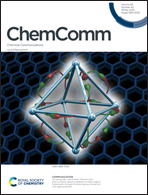Design, synthesis and applications of NIR-emissive scaffolds of diketopyrrolopyrrole-aza-BODIPY hybrids†
Abstract
Herein, we report a facile synthetic method towards diketopyrrolopyrrole-aza-BODIPY hybrids by a two-step strategy. The three resulting fluorophores (LAB-TH4 ∼ LAB-TH6) showed absorption maxima up to 637 nm with molar extinction coefficients (ε) up to 32 300 M−1 cm−1 and emission maxima at 661 nm with a fluorescence quantum yield of 25.2% in solution. Due to good biocompatibility and strong ROS generation ability, they are useful fluorophores for bioimaging and photodynamic therapy (PDT). In addition, as a useful scaffold, a novel NIR-emissive conjugated polymer can be constructed by further bromination and Suzuki coupling polymerization.



 Please wait while we load your content...
Please wait while we load your content...